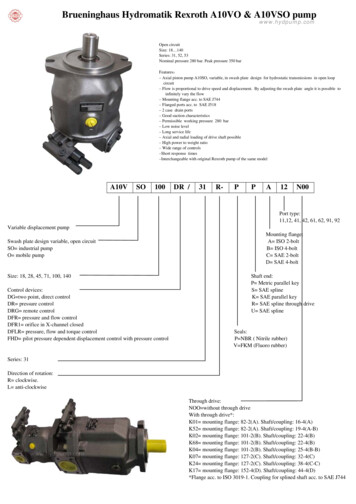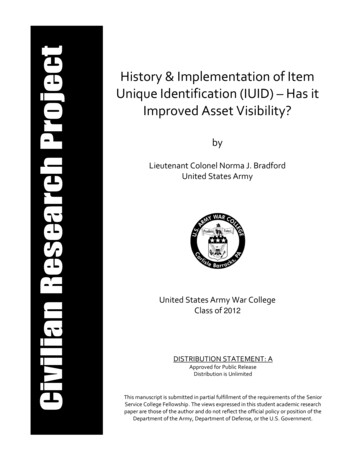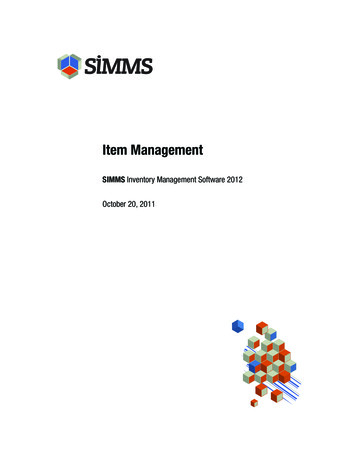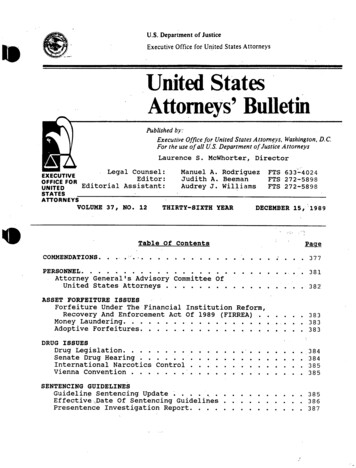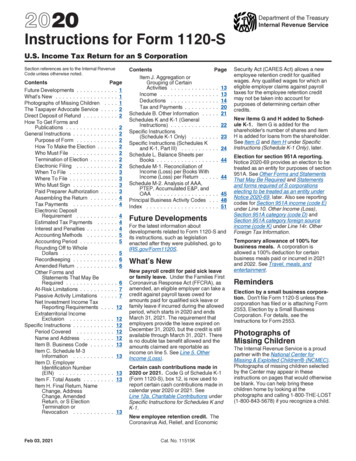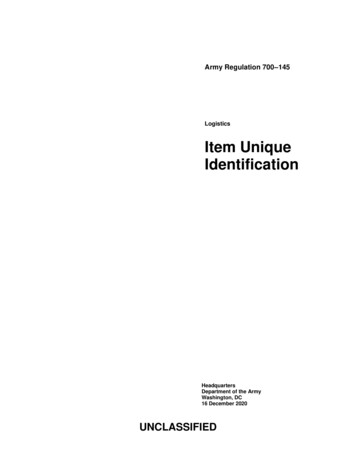
Transcription
Army Regulation 700–145LogisticsItem UniqueIdentificationHeadquartersDepartment of the ArmyWashington, DC16 December 2020UNCLASSIFIED
SUMMARY of CHANGEAR 700–145Item Unique IdentificationThis regulation is certified current on 16 December 2020. Aside from the following administrative changes, no otherchanges were made to certify the currency of this regulation—oAdds DA Pam 700–145 as procedures to this policy (para 1–1).This expedite revision, dated 18 February 2016—oUpdates item unique identification criteria (para 2–2b).oUpdates item unique identification implementation, reporting, and contracting requirements (chap 3).oAdds item unique identification cataloguing requirements (para 3–8).oUpdates the definition of legacy item (glossary).
*Army Regulation 700–145HeadquartersDepartment of the ArmyWashington, DC16 December 2020Effective 18 March 2016LogisticsItem Unique IdentificationHistory. This regulation is certifiedcur-rent on 16 December 2020. Asidefrom the changes listed in thesummary of change, no other changeswere made to certify the currency of thisregulation.Summary. This regulation implementskey provisions of DoDI 8320.03,DoDI 8320.04, and DFARS 211.274 – 5.It pre-scribes Department of the Armypolicy and responsibilities for itemunique iden-tification that includesplanning, acquir-ing, and sustaining itemunique identifica-tion for Army manageditems.Applicability. This regulation appliesto the Regular Army, the Army NationalGuard/Army National Guard of theUnited States, and the U.S. Army Reserve, unless otherwise stated.Army internal control process.This regulation contains internal controlprovisions in accordance with AR 11 –2and identifies key internal controls thatmust be evaluated (see appendix B).Proponent and exception authority.The proponent of this regulation is the Assistant Secretary of the Army (Acquisition, Logistics and Technology). The proponent has the authority to approve exceptions or waivers to this regulation thatare consistent with controlling law andregulations. The proponent may delegatethis approval authority, in writing, to a division chief within the proponent agencyor its direct reporting unit or field operating agency, in the grade of colonel or thecivilian equivalent. Activities may requesta waiver to this regulation by providingjustification that includes a full analysis ofthe expected benefits and must includeformal review by the activity’s senior legal officer. All waiver requests will be endorsed by the commander or senior leaderof the requesting activity and forwardedthrough their higher headquarters to thepolicy proponent. Refer to AR 25 –30 forspecific guidance.Supplementation. Supplementationof this regulation and establishment ofcommand and local forms are prohibitedwithout prior approval from the AssistantSecretary of the Army (Acquisition, Logistics and Technology) (SAAL–ZL), 103Army Pentagon, Washington, DC20310–0103.Suggested improvements. Usersare invited to send comments and suggested improvements on DA Form 2028(Recommended Changes to Publicationsand Blank Forms) directly to the DeputyAssistant Secretary of the Army (Acquisition Policy and Logistics) (SAAL –ZL),103 Army Pentagon, Washington, DC20310–0103.Distribution. This publication is available in electronic media only and is intended for the Regular Army, the ArmyNational Guard/Army National Guard ofthe United States, and the U.S. Army Reserve.Contents (Listed by paragraph and page number)Chapter 1Introduction, page 1Section IGeneral, page 1Purpose 1–1, page 1References and forms 1–2, page 1Explanation of abbreviations and terms 1–3, page 1Responsibilities 1–4, page 1Records management (recordkeeping) requirements 1–5, page 1Policy 1–6, page 1Section IIResponsibilities, page 1Assistant Secretary of the Army (Acquisition, Logistics and Technology) 1–7, page 1Assistant Secretary of the Army (Financial Management and Comptroller) 1–8, page 2*This regulation supersedes AR 700–145, dated 24 September 2012.AR 700–145 16 December 2020UNCLASSIFIEDi
Contents—ContinuedChief Information Officer/G–6 1–9, page 2Chief, National Guard Bureau 1–10, page 2Deputy Chief of Staff, G–3/5/7 1–11, page 2Deputy Chief of Staff, G–4 1–12, page 2Deputy Chief of Staff, G–8 1–13, page 3Deputy Chief of Staff, G–9 1–14, page 3The Surgeon General 1–15, page 3Chief of Engineers 1–16, page 3Chief, Army Reserve 1–17, page 3Chief of Chaplains 1–18, page 4Commanding General, U.S. Army Materiel Command 1–19, page 4Commanding General, U.S. Army Space and Missile Defense Command/U.S. Army Forces Strategic Command 1–20, page 4Commanding General, U.S. Army Corps of Engineers 1–21, page 4Commanding General, U.S. Army Intelligence and Security Command 1–22, page 4Commanding General, U.S. Army Special Operations Command 1–23, page 5Commanding General, U.S. Army Training and Doctrine Command 1–24, page 5Commanding General, U.S. Army Medical Research and Materiel Command 1–25, page 5Program executive officers 1–26, page 5Program managers 1–27, page 6Chapter 2Item Unique Identification Definitions, page 6Item unique identification 2–1, page 6Item unique identification criteria 2–2, page 6Non-standard Equipment 2–3, page 8Legacy item registration 2–4, page 8Chapter 3Item Unique Identification Implementation, page 8Planning 3–1, page 9Virtual unique item identifiers 3–2, page 9Marking items requiring item unique identification 3–3, page 9Registering items 3–4, page 10Budgeting 3–5, page 10Contract requirements 3–6, page 10Reporting 3–7, page 10Cataloguing and provisioning 3–8, page 10Retiring unique item identifiers 3–9, page 10Special categories 3–10, page 11AppendixesA. References, page 12B. Internal Control Evaluation, page 14Figure ListFigure 2–1: Item unique identification mandatory process flowchart, page 7Figure 2–2: Item unique identification consideration process flowchart, page 8GlossaryAR 700–145 16 December 2020ii
Chapter 1IntroductionSection IGeneral1–1. PurposeThis regulation prescribes the policy for item unique identification (IUID) in the Army. IUID facilitates informationsharing between users at all levels within a net-centric environment by establishing a unique identity for materiel(including components) that require unique item traceability or handling. IUID supports Army modernization by improving business processes that include property accountability, property valuation, serialized item management(SIM), configuration management, and product life cycle management. DA Pam 700 –145 provides procedures forthis regulation.1–2. References and formsSee appendix A.1–3. Explanation of abbreviations and termsSee the glossary.1–4. ResponsibilitiesResponsibilities are listed in section II of chapter 1.1–5. Records management (recordkeeping) requirementsThe records management requirement for all record numbers, associated forms, and reports required by this regulationare addressed in the Army Records Retention Schedule-Army (RRS–A). Detailed information for all related recordnumbers, forms, and reports are located in Army Records Information Management System (ARIMS)/RRS –A athttps://www.arims.army.mil. If any record numbers, forms, and reports are not current, addressed, and/or publishedcorrectly in ARIMS/RRS–A, see DA Pam 25–403 for guidance.1–6. PolicyThis policy—a. Defines the criteria for items requiring IUID.b. Assigns responsibilities for planning, marking items, and sustaining IUID marks within the Army.c. Sets the policy for acquiring automatic identification technology (AIT) products to mark items and capture IUIDdata.d. Applies to all government-owned materiel regardless of method of acquisition, current location, or custody arrangement.Section IIResponsibilities1–7. Assistant Secretary of the Army (Acquisition, Logistics and Technology)The ASA (ALT) will—a. Establish and develop policies and goals for the Army IUID Program.b. Designate the Deputy Assistant Secretary of the Army (Acquisition Policy and Logistics) (DASA (APL)) toserve as the approval authority for program IUID implementation plans, for which the ASA (ALT) in the capacity ofthe Army Acquisition Executive is the milestone decision authority (MDA), and acquisition category ID (see specialabbreviations and terms) plans.c. Ensure technical and functional integration and synchronization across assigned programs.d. Monitor the Army IUID effort in coordination with other Army agencies to ensure effective implementation inaccordance with Headquarters, Department of the Army requirements.e. Ensure materiel developers (MATDEVs) plan, budget, and implement IUID programs for their assigned systems.AR 700–145 16 December 20201
1–8. Assistant Secretary of the Army (Financial Management and Comptroller)The ASA (FM&C) will—a. Review program and budget requests supporting IUID.b. Provide oversight responsibility for technical aspects of IUID cost and economic analysis in the Army.c. Develop input for the Army’s Resource Formulation Guide for Army commands in support of program budgetdevelopment process.d. Develop cost estimates for programs that appear before the Army Systems Acquisition Review Council.e. Ensure that cost estimates are available for review by Headquarters, Department of the Army staff.f. Identify requirements and plan for use of the unique item identifier (UII) as a key data element for completenessreporting.1–9. Chief Information Officer/G– 6The CIO/G–6 will provide functional policy and guidance on information technology systems and networks’ use ofIUID.1–10. Chief, National Guard BureauThe CNGB will—a. Provide planning guidance, direction, control, oversight, and support necessary to ensure that IUID is implemented throughout the life cycle for Army National Guard-managed items subject to IUID criteria.b. Coordinate legacy item marking requirements with AMC and other applicable government activities to ensuremarking infrastructure is used efficiently and is not duplicated.c. Identify IUID resource requirements in the POM and applicable budget requests.d. Ensure that PD AMIS is used as a central source for AIT products and technical expertise.1–11. Deputy Chief of Staff, G– 3/5/7The DCS, G–3/5/7 will—a. Prioritize legacy equipment to be marked in support of MATDEVs; U.S. Army Materiel Command (AMC);Deputy Chief of Staff, G–4 (DCS, G–4); and Deputy Chief of Staff, G–8 (DCS, G–8).b. Identify legacy items available for IUID marking through mobile marking teams in support of MATDEVs;AMC; DCS, G–4; and DCS, G–8.1–12. Deputy Chief of Staff, G– 4The DCS, G–4 will—a. Develop operational, Automated Information System (AIS), AIT, and SIM requirements needed to use IUIDthroughout the Army Enterprise, to include property accountability and management, supply, maintenance, transportation, and supporting logistics systems in coordination with the U.S. Army Training and Doctrine Command(TRADOC).b. Ensure the UII or Department of Defense (DoD) IUID-approved equivalents are used in all unique item tracking,serial number tracking, and SIM programs.c. Resource IUID requirements and implementation strategies to ensure commonality and interoperability with allAIT infrastructure requirements and IUID data management.d. Develop supply, maintenance policy, and business processes needed to use IUID, correct two–dimensional(2–D) mark deficiencies (missing or damaged marks), and sustain applied marks throughout the Army Enterprise.e. Maintain oversight of IUID planning and implementation in the operational environment: Army depots, arsenals,and National Maintenance Program providers.f. Develop a data management strategy for IUID.g. Oversee marking by AMC and other applicable government activities to ensure marking infrastructure is usedefficiently and is not duplicated.h. Develop plans to facilitate legacy item marking and registration in the DoD IUID Registry in coordination withappropriate MATDEVs, AMC, and item managers.i. Ensure IUID resource requirements are identified in the program objective memorandum (POM) and applicablebudget requests for legacy items.j. Coordinate integration of supply-chain business processes with the Defense Logistics Agency and their Department of Defense trading partners.k. Ensure the product director automated movement and identification solutions (PD AMIS) is used as a centralsource for AIT products and technical expertise.AR 700–145 16 December 20202
l. Develop input for the Army’s Resource Formulation Guide for Army commands in support of program andbudget development processes.1–13. Deputy Chief of Staff, G– 8The DCS, G–8 will—a. Transition approved Army requirements from the planning to the programming phase of the Planning, Programming, Budgeting, and Executing System.b. Develop and defend the Army POM, Future Year Defense Program, and the independent assessment, integration, and synchronization of the Army program objective.1–14. Deputy Chief of Staff, G– 9The DCS, G–9 will—a. Provide planning guidance, direction, control, oversight, and support necessary to the U.S. Army InstallationCommand and AMC to ensure that IUID is implemented throughout the life cycle for non-centrally managed items,installation procured items, and items managed at the installation level.b. Coordinate legacy item marking requirements with AMC, DCS, G–4, and other applicable government activitiesto ensure marking infrastructure is used efficiently and is not duplicated.c. Identify IUID resource requirements in the POM and applicable budget requests.d. Ensure that PD AMIS is used as a central source for AIT products and technical expertise.e. Provide standard Armywide guidance, direction, control, oversight, and support necessary to ensure that standard IUID is implemented for tenant purchased non-standard equipment.1–15. The Surgeon GeneralTSG will—a. Provide planning guidance, direction, control, oversight, and support necessary to ensure that IUID is implemented throughout the life cycle for medical (Class VIII) materiel.b. Coordinate legacy marking requirements with AMC, the Federal Drug Administration, and other applicablegovernment activities to ensure marking infrastructure is used efficiently and is not duplicated.c. Identify IUID and unique device identification (UDI) resource requirements in the POM and applicable budgetrequests.d. Ensure that PD AMIS is used as a central source for AIT products and technical expertise.e. The U.S. Army Medical Command (MEDCOM) on behalf of TSG will implement the IUID related policies setforth in their respective areas of interest to include—(1) Providing planning guidance, direction, control, oversight, and support necessary to ensure that IUID is implemented throughout the lifecycle for MEDCOM-managed items subject to IUID criteria.(2) Coordination with applicable MATDEVs in planning IUID for MATDEV-managed items.(3) Coordination of legacy item marking requirements with AMC and other applicable government activities toensure marking infrastructure is used efficiently and is not duplicated.(4) Identification of IUID resource requirements in the POM and applicable budget requests.(5) Ensuring that PD AMIS is used as a central source for AIT products and technical expertise.1–16. Chief of EngineersThe COE will—a. Provide planning guidance, direction, control, oversight, and support necessary to ensure that IUID is implemented throughout the life cycle for COE-managed items subject to IUID criteria.b. Coordinate with applicable MATDEVs in planning IUID for MATDEV-managed items.c. Coordinate legacy item marking requirements with AMC and other applicable government activities to ensuremarking infrastructure is used efficiently and is not duplicated.d. Identify IUID resource requirements in the POM and applicable budget requests.e. Ensure that PD AMIS is used as a central source for AIT products and technical expertise.1–17. Chief, Army ReserveThe CAR will—a. Provide planning guidance, direction, control, oversight, and support necessary to ensure that IUID is implemented throughout the life cycle for U.S. Army Reserve-managed items subject to IUID criteria.AR 700–145 16 December 20203
b. Coordinate legacy item marking requirements with AMC and other applicable government activities to ensuremarking infrastructure is used efficiently and is not duplicated.c. Identify IUID resource requirements in the POM and applicable budget requests.d. Ensure that PD AMIS is used as a central source for AIT products and technical expertise.1–18. Chief of ChaplainsThe CCH will—a. Provide planning guidance, direction, control, oversight, and support necessary to ensure that IUID is implemented throughout the life cycle for Army chaplaincy-managed items subject to IUID criteria.b. Coordinate legacy item marking requirements with AMC and other applicable government activities to ensuremarking infrastructure is used efficiently and is not duplicated.c. Identify IUID resource requirements in the POM and applicable budget requests.d. Ensure that PD AMIS is used as a central source for AIT products and technical expertise.1–19. Commanding General, U.S. Army Materiel CommandThe CG, AMC will—a. Develop installation, industrial base, and depot IUID marking and registering infrastructure.b. Establish DoD IUID Registry process control guidance.c. Ensure that AMC industrial facilities plan and develop IUID marking capabilities in coordination with applicableMATDEVs and life cycle management commands.d. Manage nonrecurring engineering technical data requirements for IUID.e. Serve as the Army’s primary point of contact for IUID quality matters and develop and implement guidance andprocedures for effective IUID quality management.f. Ensure Army organic depots, arsenals, and the National Maintenance Program use IUID in their industrial, warehousing, and distribution processes.g. Ensure life cycle management commands develop IUID implementation plans and execute requirements foritems they manage (no longer MATDEV-managed).h. Establish an IUID management support office and repository for Army IUID implementation plans.i. Establish and maintain an Army IUID warehouse capability that interfaces with the appropriate logistics BusinessIntelligence/Business Warehouse capabilities, the property accountability logistics information system, and DoD IUIDRegistry.1–20. Commanding General, U.S. Army Space and Missile Defense Command/U.S. Army ForcesStrategic CommandThe CG, USASMDC will—a. Provide planning guidance, direction, control, oversight, and support necessary to ensure that IUID is implemented throughout the life cycle for USASMDC-managed items subject to IUID criteria.b. Coordinate legacy item marking requirements with AMC and other applicable government activities to ensuremarking infrastructure is used efficiently and is not duplicated.c. Identify IUID resource requirements in the POM and applicable budget requests.d. Ensure that PD AMIS is used as a central source for AIT products and technical expertise.e. Coordinate with applicable MATDEVs in planning IUID for MATDEV-managed items.1–21. Commanding General, U.S. Army Corps of EngineersThe CG, USACE will—a. Provide planning guidance, direction, control, oversight, and support necessary to ensure that IUID is implemented throughout the life cycle for USACE-managed items subject to IUID criteria.b. Coordinate with applicable MATDEVs in planning IUID for MATDEV-managed items.c. Coordinate legacy item marking requirements with AMC and other applicable government activities to ensuremarking infrastructure is used efficiently and is not duplicated.d. Identify IUID resource requirements in the POM and applicable budget requests.e. Ensure that PD AMIS is used as a central source for AIT products and technical expertise.1–22. Commanding General, U.S. Army Intelligence and Security CommandThe CG, INSCOM will—AR 700–145 16 December 20204
a. Provide planning guidance, direction, control, oversight, and support necessary to ensure that IUID is implemented throughout the life cycle for INSCOM-managed items subject to IUID criteria.b. Coordinate with applicable MATDEVs in planning IUID for MATDEV-managed items.c. Ensure that Defense Federal Acquisition Regulation Supplement (DFARS) Clause 252.211–7003 is incorporated in all new contracts and existing contracts for items as provided in DFARS Clause 211.274 –6.d. Coordinate legacy item marking requirements with AMC and other applicable government activities to ensuremarking infrastructure is used efficiently and is not duplicated.e. Identify IUID resource requirements in the POM and applicable budget requests.f. Ensure that PD AMIS is used as a central source for AIT products and technical expertise.1–23. Commanding General, U.S. Army Special Operations CommandThe CG, USASOC will—a. Provide planning guidance, direction, control, oversight, and support necessary to ensure that IUID is implemented throughout the life cycle for USASOC-managed items subject to IUID criteria.b. Coordinate with applicable MATDEVs in planning IUID for MATDEV-managed items.c. Coordinate legacy item marking requirements with AMC and other applicable government activities to ensuremarking infrastructure is used efficiently and is not duplicated.d. Identify IUID resource requirements in the POM and applicable budget requests.e. Ensure that PD AMIS is used as a central source for AIT products and technical expertise.1–24. Commanding General, U.S. Army Training and Doctrine CommandThe CG, TRADOC will—a. Develop operational, AIS, AIT, and SIM requirements needed to use IUID throughout the Army Enterprise (toinclude property accountability, supply, maintenance, logistics systems, and deployment and distribution systems)using the Joint Capabilities Integration and Development System in coordination with the DCS, G–4.b. Develop IUID training requirements for tactical Army operations.c. Provide planning guidance, direction, control, oversight, and support necessary to ensure that IUID is implemented throughout the life cycle for TRADOC-managed items subject to IUID criteria.d. Coordinate with applicable MATDEVs in planning IUID for MATDEV-managed items.e. Ensure IUID training is included in appropriate programs of instruction.1–25. Commanding General, U.S. Army Medical Research and Materiel CommandThe CG, USAMRMC will—a. Provide planning guidance, direction, control, oversight, and support necessary to ensure that IUID is implemented throughout the life cycle for USAMRMC-managed items subject to IUID criteria.b. Coordinate with applicable MATDEVs in planning IUID for MATDEV-managed items.c. Coordinate legacy item marking requirements with AMC, the Federal Drug Administration, and other applicablegovernment activities to ensure marking infrastructure is used efficiently and is not duplicated.d. Identify IUID/UDI resource requirements in the POM and applicable budget requests.e. Ensure that PD AMIS is used as a central source for AIT products and technical expertise.1–26. Program executive officersThe program executive officers will—a. Provide planning guidance, direction, control, oversight, and support necessary to ensure that IUID is implemented throughout the life cycle for assigned programs (new acquisitions and legacy).b. Ensure that DFARS Clause 252.211 –7003 is incorporated in all new contracts and existing contracts for itemsas provided in DFARS Clause 211.274 –6.c. Identify IUID resource requirements in the POM and weapon system reviews.d. Ensure that subordinate program managers develop IUID implementation plans that align with Army policy andguidance.e. Review acquisition category I program IUID implementation plans annually to determine impacts from programand policy changes and adjust, as necessary.f. Review and approve program IUID implementation plans for programs for which the program executive officeris the MDA.AR 700–145 16 December 20205
1–27. Program managersThe program managers will—a. Provide planning guidance, direction, control, oversight, and support necessary to ensure that IUID is implemented throughout the life cycle for assigned programs (new acquisitions and legacy).b. Ensure that DFARS Clause 252.211 –7003 is incorporated in all new contracts and existing contracts for itemsas provided in DFARS Clause 211.274 –6.c. Identify IUID resource requirements in the POM and weapon system reviews.d. Develop IUID implementation plans that align with Army policy and guidance and obtain approval from theassigned MDA at the next acquisition milestone.e. Review program IUID implementation plans annually to determine impacts from program and policy changes.f. Develop IUID requirements for their assigned systems using a systems engineering approach compliant withIUID policy.g. Maintain internal records sufficient to support cost analyses.h. Include IUID planning as part of supportability integrated process teams.i. Coordinate legacy item marking requirements with AMC and other applicable government activities to ensuremarking infrastructure can support IUID implementation, is used efficiently, and is not duplicated.j. Ensure that PD AMIS is used as a central source for AIT products and technical expertise.Chapter 2Item Unique Identification Definitions2–1. Item unique identificationIUID is the process of assigning a UII to personal property items in DoD inventory and physically marking the itemswith a 2–D data matrix mark that contains the UII. Personal property includes materiel systems, equipment, materials,and supplies. Real property (land and improvements to land (facilities)) and records of the Federal Government areexcluded (see DoDI 5000.64). Once an item is marked, the 2 –D mark can be scanned with an AIT device and linkedto an AIS. The UII can then be associated with data about the item throughout that item’s life cycle for improvedproduct life cycle management, property accountability and management, financial transparency, and valuation. AllUIIs are to be registered in the DoD IUID Registry once assigned to an item and upon government acceptance.a. Key characteristics of IUID are as follows:(1) UIIs are unique, unambiguous, and permanent.(2) A UII once assigned to an item is never changed (to ensure uniqueness).b. IUID supports and provides the following:(1) Multifaceted business applications.(2) The Army standard data key (the UII) to enable SIM.(3) Integration with the DoD unique identification policy that aligns acquisition, maintenance, financial, and logistics processes and associated information systems.(4) The cornerstone for life cycle traceability (see DoDI 8320.03 and DoDI 8320.04).2–2. Item unique identification criteriaa. IUID is required for all items delivered to the Government under contract, in inventory, or in use that meet thecriteria stated in paragraph 2–2b.b. MATDEVs will plan for and mark all materiel meeting the following criteria (see fig 2–1 for process flowchart):(1) Capital assets.(2) Class V DoD serially-managed items.(3) Class VII major end items.(4) Class VIII non-consumable medical items.(5) Depot Level Reparables regardless of Class (as indicated by a “D” in the fourth position of the Source, Maintenance, and Recoverability code).(6) The MATDEV will ensure that for any uniquely identified subassembly, component, or part embedded withinan item, the immediate parent item that contains the embedded subassembly, component, or part shall also be uniquelyidentified.AR 700–145 16 December 20206
Figure 2 – 1. Item unique identification mandatory process flowchartc. In addition to the mandatory UII criteria established in paragraph 2–2b, MATDEVs will review items to identifythose with a unique item level traceability requirement at any time in their life cycle using the following additionalcriteria (see fig 2–2 for process flow chart).(1) Nuclear weapons-related materiel.(2) Class II non-expendable items.(3) Small arms and light weapons.(4) Classified items.(5) Sensitive items.(6) Pilferable items.(7) Critical Safety Items.(8) Items currently serially-managed, per AR 710–3, including items in Unique Item Tracking programs.(9) Warrantied items managed in accordance with AR 700 –139.(10) Items that require periodic test, calibration, or safety inspection.(11) Unique tooling designated for preservation and storage in a Major Defense Acquisition Program will be considered a serially-managed item and require IUID.(12) Any materiel identified by the item manager as requiring unique item level traceability at any point in the lifecycle, but that does not qualify under the other categories identified.d. The requirement for unique item level traceability will be identified by the Federal Logistics Information SystemIUID Indicator. This will be determined by the manager of the item, in consultation with its users. For consumables,the materiel manager, with recommendation from the Engineering Support Activity, must identify this requirement;for reparable items, the Primary Inventory Control Activity would make this determination.AR 700–145 16 December 20207
Figure 2 – 2. Item unique identification consideration process flowchart2–3. Non-standard EquipmentNon-standard equipment catalogued in the Army Enterprise Systems Integration Program that meet the criteria inparagraph 2–2 are subject to IUID requirements. Equipment or items fabricated to support Research, Development,Testing, and Engineering but scheduled for destruction, disassembly, or modification at the conclusion of developmentand testing will not require IUID unless provided as Government Furnished Property to a contractor. Retained itemsmeeting the criterion in paragraph 2–2 will be marked before entry into the Army inventory.2–4. Legacy item registrationLegacy items that require IUID will be marked and registered in the DoD IUID Registry as soon as practical withconsideration to Army readiness, IUID implementation cost, and resourcing during the process. Legacy items that willno longe
Develop a data management strategy for IUID. g. Oversee marking by AMC and other applicable government activities to ensure marking infrastructure is used efficiently and is not duplicated. h. Develop plans to facilitate legacy item marking and registration in the DoD IUID Registry in coordination with appropriate MATDEVs, AMC, and item .
